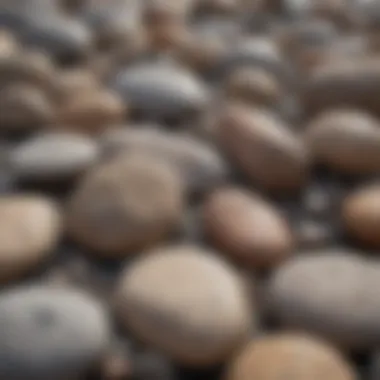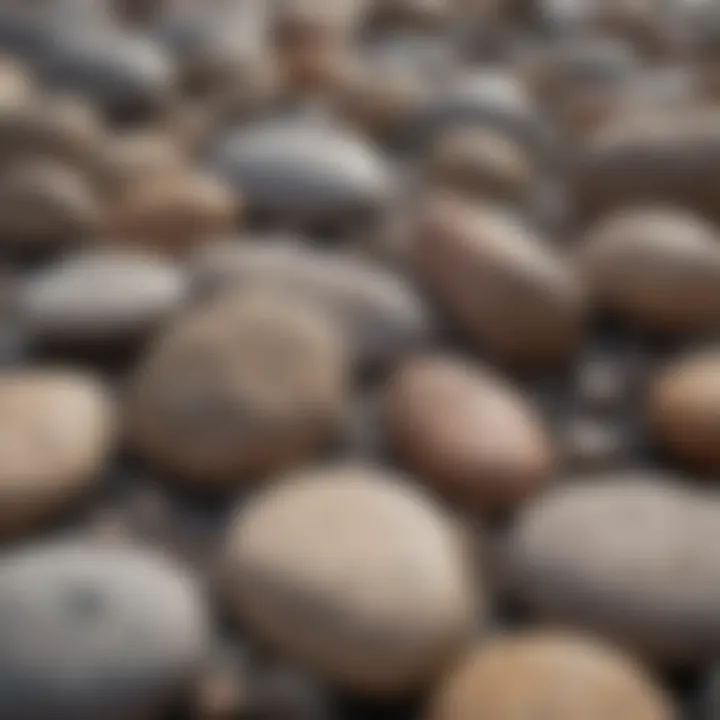Exploring the Craft of River Rock Polishing


Intro
Polishing river rocks is not just a leisurely hobby; it intertwines the realms of art and science. From seasoned collectors to curious amateurs, many find satisfaction in the glossy finish of a well-polished stone. Each smooth rock tells a tale—shaped by elements of nature and human hands alike. The journey towards creating these miniature masterpieces is rich with techniques, materials, and historical narratives.
History and Origins
Overview of Collectibles, Rocks, and Fossils
River rock polishing has roots that twist back through centuries, offering a glimpse into how humans have interacted with nature’s bounty. Rocks and fossils have long captured human imagination, prominent in cultures that valued their aesthetics and believed in their mystical properties. Collectors have roamed riverbanks for their favorite specimens, transforming rough stones into polished treasures. The thrill of discovery, coupled with the soft glimmer of polished pebbles, has made this practice a cherished pursuit for many.
Historical Significance and Cultural Impact
The art of polishing stones is not without its significance. Many ancient cultures practiced the crafting of decorative items from stones. For instance, in Native American traditions, river stones were often used for tools and ceremonial objects, demonstrating their utility beyond mere adornment. The Egyptians polished stones for jewelry, showcasing both skill and artistic fervor. This age-old tradition plays a crucial role in various ceremonies and rituals. Even today, the tactile nature of polished stones evokes feelings of connection to the earth.
"In every polished stone, there lies a whisper of nature's story, a time capsule of life's journey."
As polishing techniques evolved through the ages, so too did the appreciation of these items as collectibles. Individuals began to see value not just in their uses, but in their aesthetics and unique geological characteristics. Thus, stone polishing emerged as an artisan craft, a fusion of artistry and science.
Identification and Classification
Guide to Identifying Rocks and Fossils
Successfully collecting and polishing river rocks begins with the ability to identify different types. Understanding the rock's origin and its unique traits can enhance the polishing process. Key characteristics include color, texture, and mineral composition. For example, granite is known for its coarse texture and speckled appearance, while quartz is typically smooth and can be crystal clear. Knowledge of these features can help collectors choose the best candidates for polishing.
Common Types and Variations
The world of river rocks is diverse, comprising various types that cater to different tastes and purposes in polishing:
- Granite – Often colorful and widely available, it yields a brilliant polish.
- Jasper – Known for its intricate patterns and colors, making it a favorite among collectors.
- Limestone – Softer and easily shaped, though it may not achieve the same luster as harder rocks.
- Slate – Dark and textured, it adds character when polished but remains fragile.
- Agate – Renowned for its banding and translucency, highly sought after for jewelry making.
Each type transforms uniquely during the polishing process, creating a palette of options for collectors and artisans alike.
Prologue to River Rock Polishing
River rock polishing combines both a deft artistic touch and a scientific understanding that transforms nature's rough gems into visually stunning pieces. As simple pebbles take a journey through various stages of refinement, the end product not only serves as a piece of decoration but also carries layers of stories about their origin, history, and the very craft of polishing itself.
By delving into the intricacies of this process, enthusiasts sharpen their skills while fostering a deeper appreciation for the natural materials they work with. The pursuit can bridge the gap between art and nature, offering both a meditative pastime and a fulfilling creative outlet for individuals who are drawn to the raw beauty of stones and fossils.
Historical Perspective
River rock polishing has roots that trace back to ancient civilizations. In many cultures, polished stones held significant status. For instance, the Egyptians adored them for their use in jewelry and ceremonial items. They understood the aesthetic potential of these stones long before modern polishing techniques were developed. This practice didn’t just cater to artistic desires; it also denoted wealth and prestige.
Furthermore, through the centuries, different communities have used polished river rocks to tell stories, mark territories, or as tools in trade. Each rock embossed with the imprints of history calls upon the techniques and stories of those who lived long before us. Today, many collectors find joy in tracing these narratives through their carefully polished stones, forging a connection with the past that can be deeply rewarding.
Cultural Significance
Polished river rocks, across cultures, carry significant meanings. In various traditions, these stones are viewed as tokens of good fortune or symbols of protection. For instance, in some Native American cultures, smooth stones are often revered, representing resilience and strength against life's torrents. They are more than mere geological formations; rather, they embody the spirit of the earth.
Collecting and polishing these stones has also become a communal activity for many. Sharing knowledge about local varieties and polishing techniques fosters community relations and serves as a platform to pass down cultural practices. In essence, the art of river rock polishing transcends personal pleasure. It strengthens bonds, honors traditions, and cultivates a sense of belonging among enthusiasts.
"Every polished stone tells a story of time and transformation—an echo of nature meeting human hands."
The pursuit encapsulates a blend of creativity, storytelling, and connection to ecology that resonates even today.
Understanding River Rocks
Understanding river rocks is foundational to the art and science of polishing them. Knowing the various types of rocks at hand aids collectors and enthusiasts alike in yielding better results in the polishing process. Furthermore, gaining insight into geological formations leads to a more profound appreciation of the natural world and the worth of the stones they work with. This knowledge not only enhances one’s skills but also informs ethical practices in sourcing materials.
Types of River Rocks
Granite
Granite is often the rock star of the polishing scene. Its durability is remarkable and can withstand heavy wear during the tumbling process. The rough surface of granite, often dotted with specks of different minerals, transforms into a smooth, glassy finish that dazzles the eye.
One of its key characteristics is its ability to retain high polish due to its hardness; it ranks high on the Mohs scale, making it less susceptible to scratching compared to softer stones. This quality is not just beneficial but vital for collectors aiming for long-lasting aesthetics. However, the unique feature of granite lies in its variety; it comes in numerous colors and patterns, giving each polished piece a character of its own. On the downside, this hardness means it can take longer to polish, requiring patience and the right techniques.
Basalt
Basalt is another contender worth considering. This dark, fine-grained volcanic rock provides a contrasting look when polished. Its key characteristic is the smooth finish it achieves relatively quickly, lending itself to more rapid results for those eager to see the fruits of their labor.
The unique feature of basalt is its light weight relative to other rocks. Polishing basalt can result in a stunningly sleek surface, but it has its drawbacks. The fine grains can sometimes lead to a loss of color depth, and overly aggressive polishing methods can even dull its natural luster. For those who appreciate a more muted aesthetic, however, basalt can be an attractive choice.
Quartz
When it comes to versatility, quartz takes the cake. Clear quartz, with its key characteristic of transparency, becomes radiant when polished, showcasing unique inclusions that add to its charm. From a practical viewpoint, quartz is quite abundant and relatively easy to source, making it a go-to option for many hobbyists.
The main advantage of quartz is its availability and the variety of types, including smoky quartz and rose quartz, thus allowing for creative expression. However, while it polishes to a fantastic shine, pure quartz may require a bit more effort to achieve that high-gloss finish compared to other rocks. Furthermore, softer varieties, if not cared for properly, can easily scratch during the tumbling process.
Geological Formation


River Processes
River processes play a significant role in shaping river rocks, which is essential for anyone delving into polishing. Rivers erode materials from mountains and transport them downstream, where they undergo continuous smoothing and shaping.
This leads to an abundant variety of stones appearing on the banks – each marked by its unique journey. The key characteristic of these river processes is that they create stones which are naturally rounded, making the start of polishing easier. The unique aspect of river-rounded stones is their shape; they often have fewer sharp edges compared to other rocks that haven't undergone such natural processes, resulting in a polished piece that's more aesthetically pleasing right from the get-go. However, the unpredictability of what rocks you may find means that not every stone will be suitable for polishing.
Weathering Effects
Weathering effects further influence the rocks found in rivers. This natural process gradually breaks down stones, either physically or chemically, leading to the formation of smoother surfaces in some cases. The key characteristic of weathered stones lies in their surface texture, which may already exhibit some degree of smoothness even before polishing. This means less work is needed during the polishing process, presenting polisher with a substantial advantage.
However, a unique downside to weathering is that it may also lead to weaknesses within the stone, making it more susceptible to chipping or breaking during the tumbling process. Thus, while weathered rocks can be easier to polish, one must be cautious and choose wisely during selection.
The intricate interplay between the types of river rocks and their geological formation not only impacts their polishability but also enhances our understanding of nature's artistry.
The Process of Polishing River Rocks
Polishing river rocks isn’t just a hobby; it’s an engaging blend of art and science. This intricate process transforms rough, unassuming stones into vibrant, glossy gems, each with its own narrative. Understanding the methods employed in this craftsmanship contributes significantly to quality outcomes. From equipment choices to polishing techniques, each element plays a vital role in achieving the desired shine and smoothness.
Essential Equipment
Tumbling Machines
Tumbling machines stand as the backbone of the river rock polishing process. At their core, these machines revolve around creating a swirling environment that mimics natural erosion. A key characteristic of tumblers is their ability to hold multiple rocks at once, making them efficient for enthusiasts wanting to polish large quantities.
One unique feature of these machines is their adjustable speed settings, which allow users to control the intensity of the tumbling process. This flexibility is beneficial, as different types of stones may require various tumbling speeds and durations. However, not all tumbling machines are made equal; some are better suited for smaller projects, while others cater to more extensive collections. It’s essential to weigh options carefully, as a poor choice could lead to uneven polishing or damage to the stones.
Polishing Compounds
Polishing compounds are an essential part of enhancing the shine on river rocks. These compounds come in different grits, serving the purpose of smoothing and polishing the rock surfaces progressively. The key characteristic of polishing compounds is their abrasive quality, which helps refine rough edges and flaws. They are a popular choice among both hobbyists and serious collectors since the right mixture can bring out the natural beauty of each stone.
A unique feature here is the availability of water-soluble compounds, allowing for easier cleanup and reduced mess. However, choosing the right type and grit level of a polishing compound is crucial. Using too coarse a grit towards the end of the polishing process could dull the finish, which makes understanding these compounds paramount for effective polishing.
Safety Gear
Working with river rock polishing involves certain inherent risks. As such, safety gear becomes a non-negotiable aspect of the process. The key characteristic of reliable safety gear includes eyewear and gloves that protect against sharp edges and dust particulates that can arise from the polishing process. It’s a worthy investment that not only ensures physical safety but also promotes a smoother, uninterrupted workflow.
The unique feature of this gear is its accessibility; most hardware stores offer affordable options for every budget. However, relying solely on basic gear without understanding the material risks can lead to injuries. Therefore, prioritizing good quality safety gear is essential in ensuring that polishing remains an enjoyable and safe pastime.
Step-by-Step Polishing Techniques
Initial Cleaning
Initial cleaning is a crucial first step in the polishing process. This stage is about removing dirt, grime, and any impurities that might hinder the polishing efforts. A standout feature of this step is its focus on ensuring a clean surface, which amplifies the effectiveness of the subsequent polishing stages. Engaging in thorough cleaning is a common practice among dedicated polishers, as it showcases their attention to detail.
This step might involve soaking the rocks in water mixed with a gentle cleaner, followed by scrubbing with a soft brush. The advantage here lies in preventing any foreign particles from getting stuck during the tumbling. However, excessive scrubbing can damage delicate stones, making it important to balance thoroughness with caution.
Abrasive Tumbling
Abrasive tumbling comes next—the heart of the polishing adventure. Utilizing a mixture of coarse abrasives, this step effortlessly removes the more significant imperfections and scratches from the rocks. The key characteristic of abrasive tumbling is its robust capability to refine stone surfaces quickly and uniformly. It’s a beneficial choice because it significantly cuts down the time needed to achieve a polished finish.
One unique feature of abrasive tumbling is the ability to customize the duration based on the hardness of the stone. Yet, one must be mindful; over-tumbling can cause wear on softer stones. Thus, careful monitoring during this phase can make a world of difference in the end product.
Fine Polishing
The final touch involves fine polishing, where finer abrasives are utilized to achieve that dazzling glow. This step is when a rock's unique color and texture truly shine. One of the key characteristics of this stage is the transition from coarse abrasives to finer ones, providing a smooth surface with a reflective sheen. This is especially appealing for collectors looking to showcase their polished rocks.
An advantage of this step is that it can accentuate the rock's natural patterns and colors, making the effort worthwhile. However, relying solely on fine polishing without enough initial groundwork can lead to less-than-ideal results. Therefore, it's crucial to respect each step of the process and not rush toward the finish line.
"The finest stones emerge not from rushing, but through meticulous care and dedication—each step matters."
With these techniques, the process of polishing river rocks transforms the mundane into the extraordinary, connecting craftsmanship with nature's artistry.
Material Selection for Polishing
Choosing the right materials for river rock polishing isn't just a trivial detail; it's a cornerstone of the entire process. The rocks you select and the polishing compounds you use can dramatically influence the final outcome, not to mention the efficiency and effectiveness of your efforts. In this article, we will unravel the importance of material selection, focusing on various aspects that range from the physical characteristics of river rocks to the properties of the substances used to polish them. Making informed choices here can not only yield stunning results but also enhance the overall experience of the craft.
Choosing the Right Rocks
When it comes to polishing river rocks, the first step is selecting the right pieces to begin with.
Size Considerations
When considering the size of the rocks, it's essential to think about your end goals. Bigger rocks can show unique forms and colors, transforming the mundane into something spectacular. However, they also require more time and bigger equipment to polish effectively. On the flip side, smaller rocks are generally much easier to handle and polish, making them a popular choice among new enthusiasts. Their size allows them to tumble effectively in machines, giving consistent results in less time. The unique advantage of small stones is their quicker polishing time, thus providing instant gratification, which is quite appealing.
- Key Characteristics:
- Advantages:
- Disadvantages:
- Easier to polish when learning.
- Quick processing time.
- Immediate results can motivate collectors.
- Less wear on polishing machines.
- Smaller rocks may not showcase unique textures as larger rocks do.


Surface Quality
Surface quality holds equal weight in your material selection. Rocks with a natural sheen or smooth finish often yield much better results compared to those with rough or pitted surfaces. These natural characteristics can significantly speed up the polishing process, as they require less abrasive action and time. A key feature to consider is whether the rock has any significant blemishes; these can become more pronounced after polishing, impacting the overall aesthetic.
- Key Characteristic:
- Advantages:
- Disadvantages:
- Smoother rocks generally deliver a more uniform finish.
- Minimizes the need for vigorous tumbling or abrasive polishing, thereby extending the life of your polishing equipment.
- Easier on the hands during manual polishing.
- High-quality surface rocks might be harder to find and could cost more.
Polishing Compounds
The choice of polishing compounds completes the trio of material selection. Each type plays a significant role in achieving the desired finish and shine.
Silicon Carbide
Silicon carbide is a workhorse in the world of rock polishing. Its strength allows it to effectively shave off rough edges and prepare the rock surface for finer polishing. This makes it an essential choice for many rock enthusiasts. Not only does it have a high abrasion rate, but it is also relatively inexpensive, making it approachable for both amateurs and seasoned pros alike.
- Key Characteristic:
- Advantages:
- Disadvantages:
- Strong and effective in initial stages of polishing.
- Highly accessible and effective for a range of rock types.
- Reduces polish time significantly.
- It can be too abrasive, leading to over-polishing if not careful.
Aluminum Oxide
Aluminum oxide offers another excellent option when it comes to polishing compounds. It is known for its finer abrasive qualities, suited for the final stages of polishing after the more aggressive silicon carbide has done its job. The texture of aluminum oxide aids in producing a high-gloss finish, which is increasingly desired among collectors. Its versatility makes it suitable for various stones, ensuring that you can achieve a professional-quality look.
- Key Characteristic:
- Advantages:
- Disadvantages:
- Finer abrasive suitable for finishing touches after rough polishing.
- Excellent for achieving a glossy finish on already smooth rocks.
- Works well with multiple types of stones, providing flexibility in your project.
- Generally more expensive than silicon carbide, which can impact some budgets.
Selection of materials is half the journey in rock polishing; the right rocks and compounds can make all the difference in achieving that lustrous finish.
Environmental Considerations
When polishing river rocks, understanding the environmental considerations is crucial. As the popularity of this craft continues to grow, so does the responsibility of enthusiasts and artisans to ensure that their practices are sustainable. Incorporating eco-friendly methods not only preserves the beauty of natural resources but also fosters a deeper respect for the ecosystems from which these materials are sourced. There’s an art to balancing creativity and conservation.
Ethical Sourcing of River Rocks
One of the most pressing issues surrounding river rock polishing is ethical sourcing. Collecting stones directly from riverbeds can lead to significant ecological disturbances. It’s important to consider the following points when thinking about sourcing:
- Local Regulations: Different regions have various laws regarding the collection of natural resources. Always check local regulations before picking up rocks, as some areas are protected to preserve their natural beauty and habitats.
- Sustainable Practices: If you’re committed to maintaining ecological integrity, look into obtaining river rocks through legitimate, sustainable suppliers. These suppliers often have systems in place that prioritize the environment and can provide stones that were collected without harming local ecosystems.
- Community Involvement: Engage with local communities that rely on rivers for their livelihoods. Such discussions can reveal insights about sustainable practices and local traditions, which in turn deepen your understanding of the ecosystem's value.
"Sourcing responsibly is not just a good practice; it’s a commitment to protect nature for future generations."
Choosing the right source reflects a commitment to stewardship and will enhance the integrity of your projects.
Impact on Ecosystems
Polishing rocks can inadvertently lead to negative consequences on ecosystems if proper care is not taken. The effect can be both immediate and long-term. Here are some of the impacts to consider:
- Habitat Disruption: Removing large quantities of river rocks from a natural setting can damage habitats used by a myriad of wildlife. Aquatic life, such as fish and insects, depend on the stability of riverbeds, which can be compromised by unregulated collecting.
- Erosion Concerns: Rocks play an important role in preventing soil erosion along riverbanks. When stones are taken indiscriminately, it can lead to increased erosion, which damages the natural structure of the river and surrounding land.
- Disruption of the Natural Cycle: The removal of rocks affects the natural sediment cycle. Rocks contribute to filtering and regulating water flow. Unsustainable collecting practices can lead to problems such as increased water turbidity and loss of habitat for aquatic organisms.
To mitigate these impacts, consider:
- Limiting the volume of rocks collected to only what is necessary.
- Engaging in restoration projects where you give back to the environment.
By focusing on sustainable methods of sourcing and understanding the broader effects of our actions, rock polishing can align aesthetics with ecological health, allowing us to enjoy the beauty of polished stones without sacrificing nature.
Aesthetic Uses of Polished River Rocks
Polished river rocks are more than just smooth, gleaming stones; they are expressions of nature’s artistry and the creative endeavors of those who choose to use them for aesthetic purposes. The significance of polished river rocks in various settings cannot be overlooked, as they bring a touch of natural elegance and unique character to both indoor and outdoor spaces. This section dives into the decorative aspects of polished rocks, illustrating how they enhance our environments.
Decorative Purposes
Home écor
In the realm of interior design, polished river rocks offer a sublime option for adding a natural aesthetic to home spaces. These stones are often incorporated in various home décor items such as decorative bowls, candle holders, and accent pieces that catch the eye. One of the key characteristics of using river rocks in home décor is their versatility. They come in various colors, sizes, and shapes, making it easy to find the perfect piece that complements the overall design scheme.
Their unique feature lies in the ability to blend harmoniously with other materials like wood and glass. They introduce a sense of texture and organic warmth to environments that might otherwise feel sterile or overly modern. However, a consideration to keep in mind is the weight—larger polished stones can be cumbersome and challenging to display without proper supports.
Garden Features


When it comes to the outdoors, polished river rocks create stunning garden features that enhance the natural beauty of landscapes. These stones can be used in pathways, around flower beds, or as part of water features like fountains and ponds. The key characteristic of polished river rocks in gardens is their durability and natural appearance, which can help create a serene and peaceful environment.
Another unique feature of river rocks is how they reflect sunlight, adding a shimmering quality to outdoor settings. This attribute can significantly boost the visual appeal of any garden landscape. Nevertheless, it’s worth mentioning that using polished rocks in specific design layouts can sometimes limit plant growth if not strategically placed, leading to potential concerns about their ecological impact.
Craft and Jewelry Making
Beaded Jewelry
Polished river rocks have found their way into the craft of jewelry making, particularly in the creation of beaded jewelry that speaks to natural beauty. The specific aspect of beaded jewelry made from these rocks lies in their rustic charm and unique textures. They provide artisans with an opportunity to create unique pieces that stand apart from mass-produced jewelry.
The key characteristic of beaded jewelry using polished stones is the color variation and smoothness of each bead, as every piece tells its own story reflecting the river it came from. This makes them a beneficial choice for both makers and wearers seeking authentic and unique adornments. However, a downside to consider is that the weight of certain stones can be uncomfortable for delicate pieces, restricting their style options.
Artisan Crafts
Artisan crafts made from polished river rocks are another way to appreciate these natural wonders. From coasters and tabletops to personalized souvenirs, the specific aspect of these crafts is their craftsperson’s ability to transform simple stones into functional art. Polished river rocks, when carved or combined with other materials, can create initially unsuspected items that add character to any space.
The key characteristic of artisan crafts is their handmade quality, which often resonates more with collectors and enthusiasts, offering a unique charm and connection. However, while some crafts can be alluring, not all polished stones boast the structural integrity needed for heavy-duty items, which limits their application in more demanding crafts.
The beauty of polished river rocks not only lies in their aesthetics but also in their capacity to evoke a sense of tranquility and connection to nature.
Maintenance of Polished Rocks
Keeping polished river rocks in great shape is vital for anyone who has invested time and effort into the polishing process. Regular maintenance not only enhances their beauty but extends their lifespan. Polished stones can be quite reflective and visually appealing, but neglect can lead to dullness, scratches, and even chips. So, let’s dive into how to clean and care for these precious gems and keep them looking their best.
Cleaning and Care
Cleaning polished river rocks is not just about aesthetics; it's about preservation. Dust, dirt, and moisture can accumulate over time, dulling the shine and potentially leading to more serious deterioration. To maintain these stones effectively, it’s essential to handle them with care.
Best Practices for Cleaning:
- Rinse with warm water to remove initial dirt.
- Use a mild soap and a soft cloth or sponge to gently clean the surface.
- Avoid abrasive materials that could scratch the polished finish.
- Rinse thoroughly and dry with a soft towel to avoid water spots.
Regular cleaning not only keeps your collection stunning but also helps in identifying any potential chips or scratches early on, allowing for proactive care.
Preventing Damage
The last thing you want is to witness your beautifully polished rocks getting damaged. Preventive measures can be simple yet highly effective in maintaining their condition.
Storing Techniques
Proper storage plays a crucial role in safeguarding your polished rocks. Keeping them in a secure place can prevent accidental drops or scratches. Here are some recommended techniques:
- Keep them in a padded box or cloth bag: This can cushion against impacts. The key characteristic of this method is that it allows for stacking without risking scratches. It’s a beneficial choice for anyone looking to avoid wear and tear on the surfaces.
- Use display cases: If you want to show off your collection, opt for cases with glass or acrylic covers. These not only protect from dust but also keep your rocks visible and vibrant.
Unique feature of these storing methods is their ability to blend protection with presentation, making it an advantageous choice for collectors.
Avoiding Harsh Chemicals
Another critical aspect of maintaining your polished rocks is avoiding harsh chemicals during cleaning. Many household cleaners contain substances that can dull finishes or even etch the stone surface. Being cautious here can prolong the life of your polished masterpieces.
- Opt for mild, natural cleaners: Vinegar and lemon juice may be fine for some use but could degrade them over time if used often. Keeping it simple is a good rule of thumb. This decision reflects the growing popularity of eco-friendly practices.
- Read labels: Check for chemicals that can be corrosive or abrasive, steering clear of anything that mentions strong acids or bases. The distinctive feature of avoiding harsh chemicals is that it not only protects the stones but also aligns with environmentally conscious choices.
In summary, effective maintenance of polished river rocks through appropriate care and preventive techniques can significantly enhance their beauty and longevity. An avid collector would be well-served to adopt these practices, ensuring that each piece remains a shining star in their collection.
Community and Resources
Understanding the community and resources available for those interested in river rock polishing is crucial. Whether you are a novice or a seasoned expert, connecting with others who share the same passion can enhance your knowledge and skills. Not only does it provide learning opportunities, but it also fosters a sense of belonging in a niche hobby that is rich in history and techniques.
Joining Collectors' Groups
Local Clubs
Local clubs play a significant role in the realm of river rock polishing. These clubs create a space where collectors can congregate. The atmosphere is often informal, allowing for easy networking among enthusiasts. One key characteristic of local clubs is the hands-on experience they offer; members frequently share tips and techniques, enabling a practical understanding that books alone cannot provide. The beneficial aspect of local clubs lies in their community spirit. Often, members find friendship and support, which can enhance their enjoyment of the hobby.
Unique Feature: Local clubs often organize field trips to river sites, providing first-hand opportunities to collect new rocks and learn from more experienced members. However, they may face certain limitations, such as having fewer resources compared to larger organizations.
Online Forums
On the flip side, online forums present a different avenue for engagement. These virtual spaces allow members from all corners of the globe to share their insights and ask questions at any time of the day. A standout aspect of online forums is the immediacy of feedback; you can post a question and, more often than not, receive expert advice within hours. This characteristic makes online forums a popular choice for those delving into river rock polishing.
Unique Feature: Online forums excel in their ability to archive conversations. New members can refer back to previous discussions for a wealth of accumulated knowledge. However, the downside can be the overwhelming amount of information available, which can be daunting for newcomers.
Educational Resources
Workshops and Seminars
Participating in workshops and seminars can be a game-changer for anyone keen on polishing river rocks. These interactive sessions often involve expert demonstrations, allowing participants to see techniques performed in real-time. Workshops are particularly beneficial because they encourage questions and discussions, fostering an atmosphere of shared learning.
Unique Feature: Unlike online resources, workshops provide immediate hands-on experience with materials and equipment, which is invaluable for skill-building. One limitation, however, is that workshops often come with a fee, which may not be feasible for everyone.
Books and Publications
Unique Feature: Many books include detailed photographs and illustrations, giving readers a visual guide that can significantly enhance comprehension. However, keeping up with the latest techniques may be a bit challenging since print materials can become outdated quickly.
"Knowledge shared is knowledge doubled; learning from others in the community can elevate your skills exponentially."
Engaging with community resources in diverse ways strengthens one’s understanding of river rock polishing. It is important to choose the avenues that align with your learning style and preferences.



